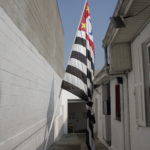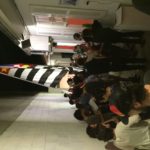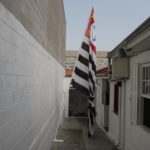estado | Gustavo Torrezan
Escrever estado em minúscula, por Yudi Rafael
{english below}
Do centro de São Paulo, é possível avistar uma enorme bandeira do estado hasteada no alto do terraço do edifício Altino Arantes. Sua posição é estratégica – o prédio já foi o mais alto da cidade, localizado no ponto mais alto da região central – e emblemática dos modos de exibição pública de um símbolo oficial. Inaugurado em 1947, pouco depois do final da 2 a Guerra Mundial, o projeto do edifício Altino Arantes fora adaptado para que se assemelhasse ao Empire State Building, ícone cultural do poderio estadunidense na nova configuração geopolítica mundial do pós-guerra.
Em estado, a bandeira içada em mastro no Ateliê397 aparece vulnerável, a meio passo entre a imponência monumental que o aparecimento do símbolo implica e a proximidade ao corpo a que o trabalho a submete. Retorcida por um nó em sua porção central e instalada num local de passagem, ela passa a integrar, de forma desajeitada, o espaço aberto do corredor. Suas dimensões agigantadas competem com a escala arquitetônica, e a torção em nó restringe sua movimentação e abertura, suprimindo seus elementos heráldicos.
Uma bandeira oficial é concebida como elemento simbólico a ser manipulado e exibido sob procedimentos de um protocolo rigoroso, e costuma pairar sobre nossas cabeças, hasteada em mastros nas proximidades de fachadas de edifícios do poder público. Se o modo de exibição da bandeira é condição essencial do exercício pleno de sua dimensão simbólica, o ícone deslocado no trabalho de Gustavo Torrezan causa estranhamento.
A estranheza de sua presença no corredor do Ateliê397 sugere a imagem do Leviatã, colossal e implacável, confinado em quarentena, sob observação. Mas o Estado pode ser pensado em termos de processos de estatização, na esteira da proposição de Foucault de que o Estado nada mais seria que o ‘efeito móvel’ de perpétuas estatizações, de um regime de governamentalidades múltiplas [1]. É possível vislumbrar, então, uma dinâmica de organização em sociedade cujo funcionamento busque, incessantemente, impedir o surgimento do Estado.
Em sua tese sobre a ausência do Estado em sociedades amazônicas [2] , o antropólogo Pierre Clastres defende que a mesma não deriva de alguma falta ou incapacidade, mas é produto de uma atitude ativa de recusa do Estado, de uma tecnologia específica voltada para a neutralização da tirania e dos processos de estatização – “mais contra o Estado do que sem Estado”. Se certas sociedades não visam necessariamente ao Estado, ou seja, se não podem ser qualificadas por um viés evolucionista e teleológico no sentido de tal conformação, então a equação pode se inverter, e aquilo que era determinado de maneira negativa, em termos de falta, pode assumir-se como positividade.
Assim, ao deslocar uma bandeira oficial de um edifício do poder público para um espaço independente, re-configurando seu lugar de exibição, Torrezan faz dela refém, aproximando-a do público e de suas interrogações. Constrangido, o símbolo capturado suscita reflexões sobre as múltiplas faces dos agenciamentos implicados na afirmação do Estado, e indica, sobretudo, a possibilidade de dobrá-los.
1 FOUCAULT, Michel. Aula de 31 de janeiro de 1979. Em: Nascimento da biopolítica: curso dado no Collège de France (1978-1979). São Paulo: Martins Fontes, 2008.
2 CLASTRES, Pierre. A sociedade contra o Estado – pesquisas de antropologia política. Edição Cosac Naify Portátil. São Paulo: Cosac Naify, 2013.
Gustavo Torrezan. Nasceu em 1984, em Piracicaba-SP. Vive e trabalha em São Paulo-SP. É artista, pesquisador, etc. Realiza doutorado em poéticas visuais sob orientação do Professor Doutor Marco do Valle no Instituto de Artes da Unicamp. Mestre em educação e graduado em Artes Visuais na mesma universidade. Realizou as exposições individuais “invenire” (2015), “desviantes” (2014), “notas de ascensão e morte desde uma terra incognita” (2013) e “ESCAPA” (2012), entre outras.
Yudi Rafael é pesquisador, crítico e curador. Bacharel em Ciências Sociais pela Universidade Federal de Santa Catarina e especialista em Arte: Crítica e Curadoria pela PUC-SP, foi curador-assistente do Ateliê397 e coordenador editorial do livro Ateliê397: 2010-2015. Foi colaborador da revista Bazaar Art Brasil (2015), curador da exposição coletiva primeiro de maio (São Paulo, 2015) e de 1:1 (2014), individual de Shima na Casa Contemporânea, onde organizou o seminário Diálogos em torno da performance “A quarta raça”.
Writing state in lowercase, by Yudi Rafael
A huge São Paulo state flag flutters on top of the Altino Arantes building, in São Paulo downtown. Its position is strategic – the building was once the tallest in the city, located at the highest spot in the central area – and symbolic of the modes of public display of an official symbol. Inaugurated in 1947, shortly after the end of World War II, the design for the Altino Arantes building had been adapted to resemble the Empire State Building, a cultural icon of the American power in the new world geopolitical configuration of the post-war period.
In state, the flag fluttering on a pole at Ateliê397 looks vulnerable, half way between the monumental grandeur implied by the appearance of the symbol and the proximity to the body to which it is subject as a result of the work. Twisted by a knot in the middle and placed in a passage, it becomes part – awkwardly, though – of the open space of the corridor. Its big size competes with the architectural scale, and the twisted knot limits its movement and opening, suppressing its heraldic elements.
An official flag is devised as a symbolic element to be handled and shown according to the procedures of a strict protocol, and usually hangs over our heads attached to flagpoles near the façades of government buildings. If the way in which a flag is displayed is an essential condition for fully exercising its symbolic dimension, the icon relocated in Gustavo Torrezan’s work causes estrangement.
The strangeness of its presence in Ateliê397’s corridor suggests the colossal, relentless image of Leviathan, kept in quarantine, under observation. But the State may be thought of in terms of étatisation [state control, ‘statification’ processes in the wake of Foucault’s proposition that the State is nothing else but the ‘mobile effect’ of perpetual étatisation, of a regime of multiple governmentalities 1 . Thus, it is possible to envisage the dynamics of organization in society, whose functioning constantly seeks to prevent the appearance of the State.
In his thesis on the absence of the State in the Amazon communities 2, anthropologist Pierre Clastres argues that it does not result from any failure or incapacity, but is the consequence of an active refusal of the State, a specific technology designed to neutralize tyranny and étatisation processes – “more against the State than without State”. If certain companies do not necessarily a im at the State, that is, if they cannot be described by an evolutionist and teleological bias towards such conformation, then the equation can be reversed and what was defined negatively in terms of failure can be assumed as positive.
Therefore, by relocating an official flag from a government building in an independent space and reconfiguring the place in which it is displayed, Torrezan holds it hostage and brings it closer to the audience and its questions. Embarrassed, the captured symbol encourages reflections about the multiple aspects of the assemblages implied in the State affirmation, and particularly opens up the possibility of precluding them.
1 FOUCAULT, Michel. Aula de 31 de janeiro de 1979. Em: Nascimento da biopolítica: curso dado no Collège de France (1978-1979). São Paulo: Martins Fontes, 2008.
2 CLASTRES, Pierre. A sociedade contra o Estado – pesquisas de antropologia política. Edição Cosac Naify Portátil. São Paulo: Cosac Naify, 2013.
Gustavo Torrezan (Piracicaba/SP, 1984; lives and works in São Paulo) is an artist, researcher, etc. He is currently working on a doctorate in Visual Poetics at the Arts Institute at Unicamp, under the guidance of Marco do Valle, Ph.D. Master of Education, a degree and BA in Visual Arts from the same university. Participated in the PIESP program (2013-2014), coordinated by Adriano Pedrosa and Ana Paula Cohen, at the São Paulo School. Has participated on a regular basis in solo and group exhibitions since 2006.
Yudi Rafael (São José dos Campos/SP, 1985; lives and works in São Paulo) is a researcher, critic and curator. Holds a BA in Social Sciences from Federal Santa Catarina University and has a major in Art Criticism and Curatorship from PUC-SP. Worked as assistant curator at Ateliê397 and editorial coordinator for the book, Ateliê397: 2010-2015. Worked as collaborator for the BazaarArt Brasil magazine, curator for the group exhibition primeiro de maio [May 1 st ] (SãoPaulo, 2015) and 1:1 (2014), a solo exhibition by Shima at Casa Contemporânea, where he organized the seminar, Diálogos em torno da performance “A quarta raça” [Dialogues on the performance “The fourth race”].













